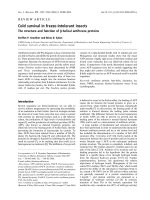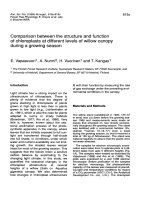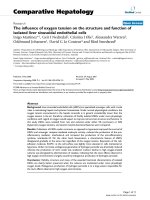Lecture AP Biology Chapter 5 The structure and function of large biological molecules
Bạn đang xem bản rút gọn của tài liệu. Xem và tải ngay bản đầy đủ của tài liệu tại đây (4.53 MB, 48 trang )
Warm-Up
1. What are the 4 classes of macromolecules?
Give an example of each.
2. Draw and label the parts of an amino acid.
3. How are 2 amino acids put together? Name
the process and describe what happens.
4. Draw a tripeptide. (Use Google for help)
Label the peptide bonds.
Peptide Bonds
Warm-Up
1. What are the 4 classes of
macromolecules?
2. Give an example of each type of
macromolecule.
Ch. 5 Warm-Up Activity
In your family groups, complete #1-5
on Activity 4/5.1: “How can you
identify organic
macromolecules?”
Warm-Up
1. What are the 4 levels of protein
structure? What bonds are formed in
each level?
2. Which protein was involved in the
curds & whey lab yesterday?
3. Explain what happened to the milk to
form the curds and whey.
Chapter 5
The Structure and Function of
Large Biological Molecules
You Must Know
•
•
•
•
•
The role of dehydration synthesis in the formation of
organic compounds and hydrolysis in the digestion of
organic compounds.
How to recognize the 4 biologically important
organic compounds (carbs, lipids, proteins, nucleic
acids) by their structural formulas.
The cellular functions of all four organic compounds.
The 4 structural levels of proteins
How proteins reach their final shape (conformation)
and the denaturing impact that heat and pH can have
on protein structure
Monomers
•Small organic
•Used for building
blocks of polymers
•Connects with
condensation reaction
(dehydration synthesis)
Polymers
Macromolecules
•Long molecules of
•Giant molecules
monomers
•2 or more polymers
•With many identical or bonded together
similar blocks linked by
covalent bonds
ie. amino acid peptide polypeptide protein
smaller
larger
Dehydration Synthesis
(Condensation Reaction)
Hydrolysis
Make polymers
Breakdown polymers
Monomers Polymers
Polymers Monomers
A + B AB
AB A + B
+
+ H2 O
+ H2O
+
Dehydration Synthesis
Hydrolysis
I. Proteins
• “Proteios” = first or primary
• 50% dry weight of cells
• Contains: C, H, O, N, S
Myoglobin protein
Protein Functions (+ examples)
•
•
•
•
•
•
•
•
Enzymes (lactase)
Defense (antibodies)
Storage (milk protein = casein)
Transport (hemoglobin)
Hormones (insulin)
Receptors
Movement (motor proteins)
Structure (keratin)
Overview of protein functions
Overview of protein functions
Four Levels of Protein Structure
1. Primary
Amino acid (AA) sequence
20 different AA’s
peptide bonds link AA’s
Amino Acid
• R group = side
chains
• Properties:
•
•
•
hydrophobic
hydrophilic
ionic (acids & bases)
• “amino” : -NH2
• “acid” : -COOH
Four Levels of Protein Structure (continued)
2. Secondary
Gains 3-D shape (folds, coils) by H-bonding
Alpha (α) helix, Beta (β) pleated sheet
Basic Principles of Protein Folding
A. Hydrophobic AA buried in interior of protein
(hydrophobic interactions)
B. Hydrophilic AA exposed on surface of protein
(hydrogen bonds)
C. Acidic + Basic AA form salt bridges (ionic
bonds).
D. Cysteines can form disulfide bonds.
Four Levels of Protein Structure (continued)
3. Tertiary
Bonding between side chains (R groups) of amino acids
H bonds, ionic bonds, disulfide bridges, van der Waals
interactions
Four Levels of Protein Structure (continued)
4. Quaternary
2+ polypeptides bond together
amino acids polypeptides protein
Bonding (ionic & H) can create
asymmetrical attractions









